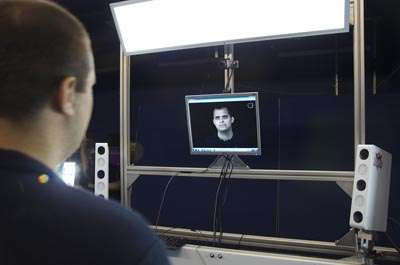Next step in facial imaging (w/ Video)

A team of University clinicians and computer scientists can, for the first time, carry out facial movement research and transform the way patients needing facial surgery are diagnosed and monitored thanks to a new state-of-the-art 3D surface motion imaging system.
Working alongside a leading company in the field, 3dMD, a team of University academics have developed the first commercial system capable of recording moving human images in 3D.
"Research into facial movement has important applications in patients whose facial movement is affected by conditions such as a cleft lip, neurological conditions such as Parkinson's disease or someone who has experienced a stroke," according to Consultant Orthodontist, Dr Hashmat Popat, School of Optometry and Vision Sciences.
"Videos have generally been the preferred method for recording facial movements – unfortunately, they are only-two dimensional so when analysing how the face moves, important data is lost," he adds.
In 2005 the Team commissioned the first commercial 3D scanner capable of recording moving human images – like a video camera, but in 3D and have helped develop a new generation of high speed, high quality 3dMDdynamic system.
"Even today, videos are the most widely used method for recording facial movements, however a 2D video is unable to support true measurements of 3D shape and how this changes with facial expressions," according to Professor David Marshall, Computer Science & Informatics.
"When 3dMD's technology first became available our team was determined to move from 2D to 3D video to measure with precision the dynamic aspects of facial soft tissue movement and expression.
"Research into more general 3D dynamic facial expression analysis and their application to biometric identification, expression recognition, like a smile and computer graphics and animation has also been productive, including joint work with Psychologists.
"Furthermore due to the unique position of having two such systems available we have been pioneering work in Conversational Expressions where we have recorded and are analysing the 3D facial dynamics of two people engaged in a conversation," he adds.
Working closely with 3dMD Professor Stephen Richmond and Dr Hashmat Popat from the School of Dentistry and Professor David Marshall and Professor Paul Rosin from the School of Computer Science & Informatics have pioneered the use of 3D video analysis.
"As 3dMD developed its ground breaking technology to the next level, there has been no question that we have to work closely with the team who has had the most published research experience to date in the field of dynamic 3D applications," according to 3dMD's CEO, Chris Lane.
"The team at Cardiff University has pushed 3dMD to make many breakthroughs such as our 60fps 3D capture frame rate and more recently enhanced non-intrusive lighting and texture capability opening up the possibility of a very dense optical tracking capability to understand and quantify the subtleties of soft tissue deformation during facial movement in babies, children and adult subjects."
"Our team is excited to use this latest technology to push the envelope in patient care," adds Professor Stephen Richmond.
"Not only will we be able to objectively assess a patient's functional outcome and how others in the community react to the outcome, our team will be able to start advancing computerized simulation models to replicate facial expression and functional behaviour for those patients undergoing treatment."
Provided by Cardiff University



















